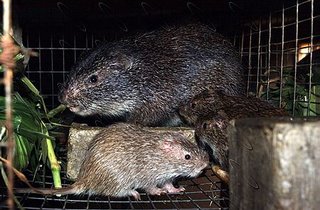
Waaaaaay down South
(It’s true; there’s only one PCV in country who’s further south than I am)
*an article I just wrote for our environmental education newsletter. And keep in mind that these are the rantings of a *former* vegetarian...*
Mvangan is a village of 2000 people in the South province, about 50 km from the natural border with Gabon. It’s both the seat of the arrondissement and the seat of the health district (I’m based at the district hospital), but being in the South province, there are few people, little infrastructure, and few income-generating projects going on. The main economic activities are cocoa farming and bush meat hunting.
So….what’s in the South…besides the beautiful equatorial rainforest, the childhood home of Paul Biya, the Bulu, several land/animal reserves, KRIBI, and Ebolowa, provincial capital and “gem of the South”? Well, there’s a lot of bush meat. And I know bush meat used to be the buzzword (and only word…) of EE, but it’s true – bushmeat and manioc are the staple foods in the South province. And that in itself provides a lot of Health/EE opportunities, but for now…I’ll focus on bush meat…and its new, lovely, photogenic alternative – the cane rat.
And it tastes like chicken. (awww)(….dinner!)
Through a partnership with Heifer International, Peace Corps is funding cane rat training for farmers in several provinces. Two planters from my village are attending two weeks of cane rat training this month, with training and progenitors (one male and three females – rodent polygamy). As I recently completed two hours of cane rat training [with the (currently) sole raiser of cane rats in the South province], I consider myself an unqualified expert who can tell you everything you ever wanted to know about cane rats but never thought to ask.
First, why cane rats? (besides that they taste like chicken)
Cane rats are also called aulacodes or herissons in French. Similar to guinea pigs (calico-colored, overgrown hamsters? Yep, they’re good food too), they look like a cross between rats, rabbits, and hedgehogs. One cane rat can fetch as much as 15.000 F CFA at the current market rate – this meat is pretty special. Cane rats are easy to domesticate, are relatively cheap to feed (grass, anyone? Little bit o’ manioc and corn?) and being polygamous, reproduce at a fantastic (for the breeder) and alarming (for the mother) rate. One female cane rat, after a gestation of 5 months, can have a litter of 2 – 15 furry little drumsticks…
And that’s probably more than you ever wanted to know.
But. Introducing and promoting alternative sources of protein to bush meat (and this can also include plants like soy and moringa) can a) help reduce hunting pressure on wild species 2) add protein to the diet by having more consistent sources available (yay health!) and 3) provide an excellent income-generating activity for your community. And this will hopefully tie into future/in-the-planning nutrition animations in the community. The Bulu are traditionally hunters, and meat = pride. Introducing non-animal forms of protein is an uphill battle, but worth the challenge.
No comments:
Post a Comment